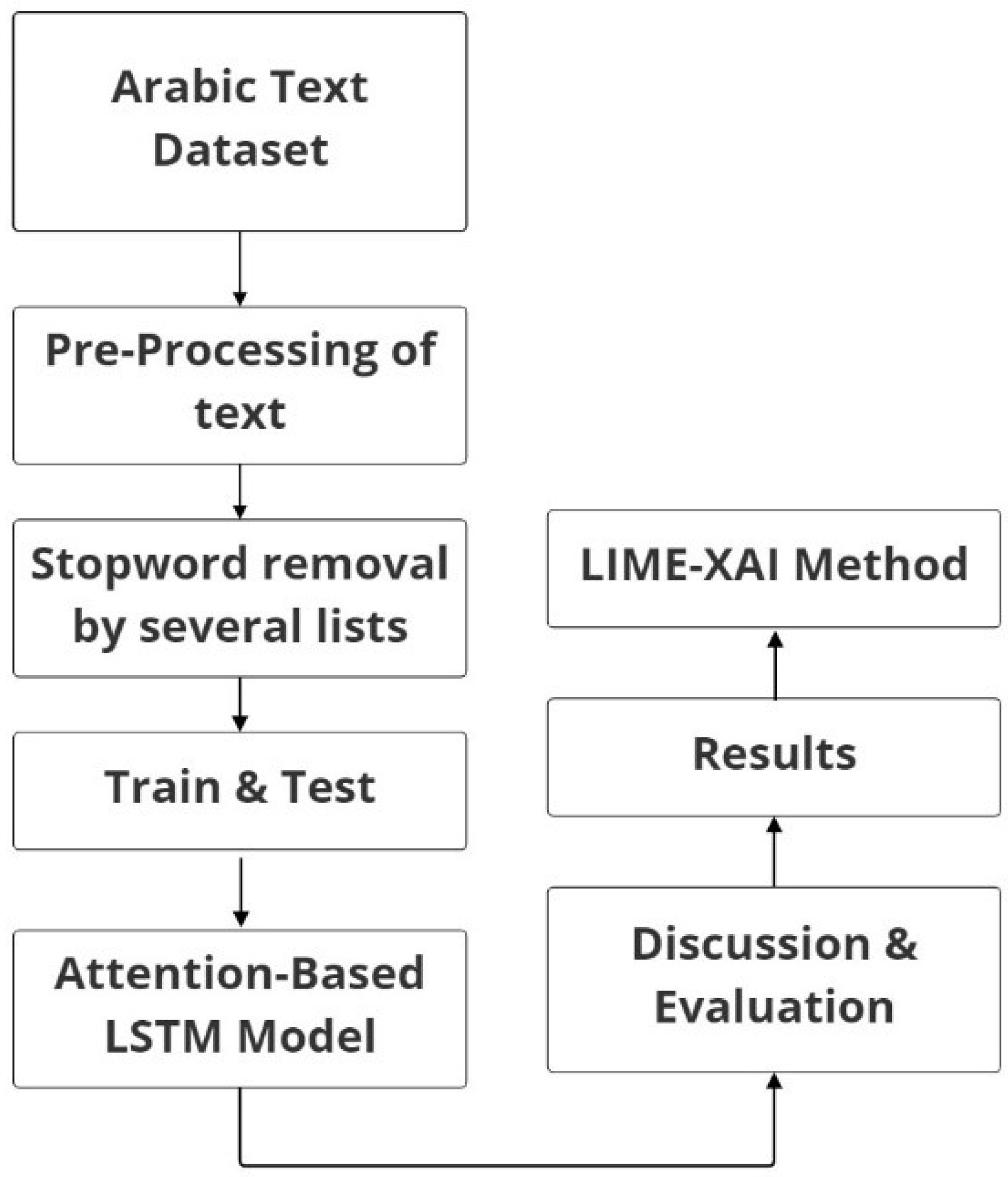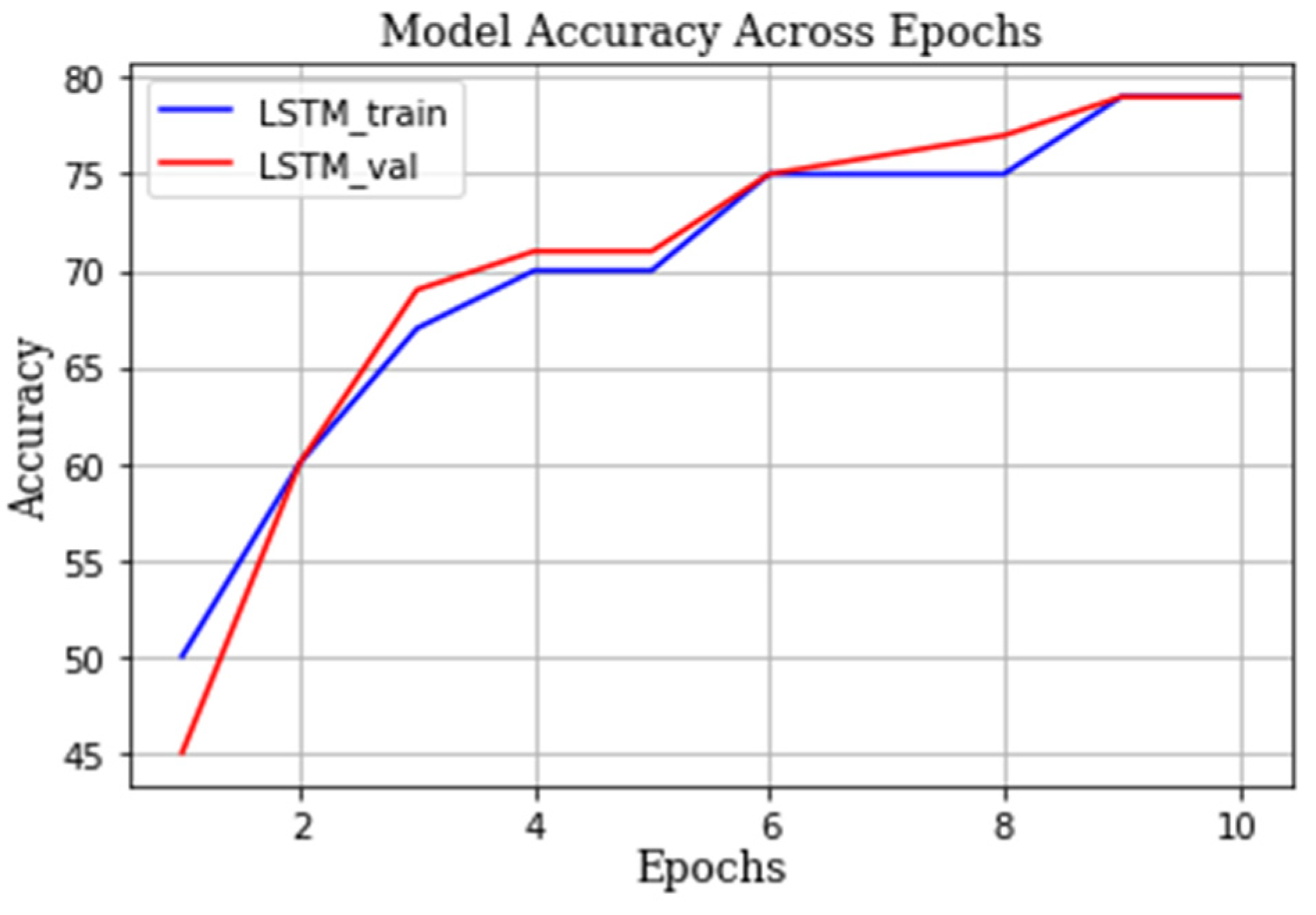Justifying Arabic Text Sentiment Analysis Using Explainable AI (XAI): LASIK Surgeries Case Study
Abstract
1. Introduction
2. Literature Review
3. Background
3.1. XAI Tools
3.2. LASIK Surgeries
4. Materials and Methods
4.1. Data Set Creation
4.2. Data Pre-Processing
4.3. Feature Selection
4.4. LSTM Model
4.5. Applying LIME XAI Method
5. Discussion
6. Conclusions
Author Contributions
Funding
Data Availability Statement
Conflicts of Interest
Abbreviations
| Abbreviation | Terminology |
| DL | Deep learning |
| ML | Machine Learning |
| LIME | Local Interpretable Model-agnostic Explanations |
| LSTM | Long Short-Term Memory |
| SHAP | SHapley Additive exPlanations |
| ASA | Arabic Sentiment Analysis |
References
- Fiok, K.; Farahani, F.V.; Karwowski, W.; Ahram, T. Explainable artificial intelligence for education and training. J. Def. Model. Simul. Appl. Methodol. Technol. 2021, 19, 133–144. [Google Scholar] [CrossRef]
- Arrieta, A.B.; Díaz-Rodríguez, N.; del Ser, J.; Bennetot, A.; Tabik, S.; Barbado, A.; García, S.; Gil-López, S.; Molina, D.; Benjamins, R.; et al. Explainable Artificial Intelligence (XAI): Concepts, taxonomies, opportunities and challenges toward responsible AI. Inf. Fusion 2020, 58, 82–115. [Google Scholar] [CrossRef]
- Feldman, R. Techniques and applications for sentiment analysis. Commun. ACM 2013, 56, 82–89. [Google Scholar] [CrossRef]
- Yang, L.; Li, Y.; Wang, J.; Sherratt, R.S. Sentiment analysis for E-commerce product reviews in Chinese based on sentiment lexicon and deep learning. IEEE Access 2020, 8, 23522–23530. [Google Scholar] [CrossRef]
- Kim, H.; So, K.K.; Wirtz, J. Service robots: Applying social exchange theory to better understand human–robot interactions. Tour. Manag. 2022, 92, 104537. [Google Scholar] [CrossRef]
- Oueslati, O.; Cambria, E.; HajHmida, M.B.; Ounelli, H. A review of sentiment analysis research in Arabic language. Future Gener. Comput. Syst. 2020, 112, 408–430. [Google Scholar] [CrossRef]
- Aljameel, S.S.; Alabbad, D.A.; Alzahrani, N.A.; Alqarni, S.M.; Alamoudi, F.A.; Babili, L.M.; Aljaafary, S.K.; Alshamrani, F.M. A sentiment analysis approach to predict an individual’s awareness of the precautionary procedures to prevent COVID-19 outbreaks in Saudi Arabia. Int. J. Environ. Res. Public Health 2021, 18, 218. [Google Scholar] [CrossRef] [PubMed]
- Abdelwahab, Y.; Kholief, M.; Sedky, A. An experimental survey of ASA on DL classifiers using multi-dialect arabic texts. In Proceedings of the Future of Information and Communication Conference 2022, San Francisco, CA, USA, 3–4 March 2022. [Google Scholar]
- Alaff, A.J.; Mukhairez, H.H.; Kose, U. An explainable artificial intelligence model for detecting COVID-19 with twitter text classification: Turkey case. In Proceedings of the International Conference on Computing and Communication Systems 2021, Shillong, India, 28–30 April 2020; Springer: Singapore, 2020; pp. 87–97. [Google Scholar]
- Rathore, R.K.; Kolonin, A. Explorative study of explainable artificial intelligence techniques for sentiment analysis applied for english language. In Proceedings of the International Conference on Paradigms of Communication, Computing and Data Sciences 2022, Kurukshetra, India, 7–9 May 2021; Springer: Singapore, 2021; pp. 861–868. [Google Scholar]
- Gite, S.; Khatavkar, H.; Srivastava, S.; Maheshwari, P.; Pandey, N. Stock prices prediction from financial news articles using LSTM and XAI. In Proceedings of the Second International Conference on Computing, Communications, and Cyber-Security 2021, Delhi, India, 3–4 October 2020; Springer: Singapore, 2020; pp. 153–161. [Google Scholar]
- Adak, A.; Pradhan, B.; Shukla, N.; Alamri, A. Unboxing deep learning model of food delivery service reviews using explainable artificial intelligence (XAI) technique. Foods 2022, 11, 2019. [Google Scholar] [CrossRef] [PubMed]
- Chowdhury, K.R.; Sil, A.; Shukla, S.R. Explaining a black-box sentiment analysis model with local interpretable model diagnostics explanation (LIME). In Advances in Computing and Data Sciences, Proceedings of the 5th International Conference on Advances in Computing and Data Sciences, Nashik, India, 23–24 April 2021; Springer: Cham, Switzerland, 2021; pp. 90–101. [Google Scholar]
- Kumar, A.; Dikshit, S.; Albuquerque, V.H. Explainable artificial intelligence for sarcasm detection in dialogues. Wirel. Commun. Mob. Comput. 2021, 2021, 2939334. [Google Scholar] [CrossRef]
- Choi, I.H.; Kim, Y.S.; Lee, C.K. A Study of the classification of IT jobs using LSTM and LIME. In Proceedings of the 9th International Conference on Smart Media and Applications, Jeju, Korea, 17–19 September 2020; pp. 248–252. [Google Scholar]
- Tang, G.; Zhang, L.; Yang, F.; Meng, L.; Cao, W.; Qiu, M.; Ren, S.; Yang, L.; Wang, H. Interpretation of learning-based automatic source code vulnerability detection model using LIME. In Knowledge Science, Engineering and Management, Proceedings of the International Conference on Knowledge Science, Engineering and Management, Tokyo, Japan, 14–16 August 2021; Springer: Cham, Switzerland, 2021; pp. 275–286. [Google Scholar]
- Aporna, A.A.; Azad, I.; Amlan, N.S.; Mehedi, M.H.; Mahbub, M.J.; Rasel, A.A. Classifying offensive speech of bangla text and analysis using explainable AI. In Advances in Computing and Data Sciences, Proceedings of the 6th International Conference on Advances in Computing and Data Sciences, Kurnool, India, 22–23 April 2022; Springer: Cham, Switzerland, 2022; pp. 133–144. [Google Scholar]
- Pérez-Landa, G.I.; Loyola-González, O.; Medina-Pérez, M.A. An Explainable Artificial Intelligence Model for Detecting Xenophobic Tweets. Appl. Sci. 2021, 11, 10801. [Google Scholar] [CrossRef]
- Ribeiro, M.T.; Singh, S.; Guestrin, C. “Why should i trust you? ” Explaining the predictions of any classifier. In Proceedings of the 22nd ACM SIGKDD International Conference on Knowledge Discovery and Data Mining, San Francisco, CA, USA, 13–17 August 2016; pp. 1135–1144. [Google Scholar]
- Lundberg, S.M.; Lee, S.I. A unified approach to interpreting model predictions. Adv. Neural Inf. Process. Syst. 2017, 30, 4768–4777. [Google Scholar]
- Malandri, L.; Mercorio, F.; Mezzanzanica, M.; Nobani, N.; Seveso, A. ContrXT: Generating contrastive explanations from any text classifier. Inf. Fusion 2022, 81, 103–115. [Google Scholar] [CrossRef]
- Rajagopal, D.; Balachandran, V.; Hovy, E.; Tsvetkov, Y. Selfexplain: A self-explaining architecture for neural text classifiers. arXiv 2021, arXiv:2103.12279. [Google Scholar]
- Guidotti, R. Evaluating local explanation methods on ground truth. Artif. Intell. 2021, 291, 103428. [Google Scholar] [CrossRef]
- Alsabaani, N.; Alshehri, M.S.; AlFlan, M.A.; Awadalla, N.J. Prevalence of laser refractive surgery among ophthalmologists in Saudi Arabia. Saudi J. Ophthalmol. 2020, 34, 116. [Google Scholar] [CrossRef] [PubMed]
- Boyd, K. LASIK—Laser Eye Surgery. American Academy of Ophthalmology. 23 August 2022. Available online: https://www.aao.org/eye-health/treatments/lasik (accessed on 23 August 2022).
- Abdelfattah Youmna. LasikSurgery-Arabic-Text-Dataset. Kaggle.com. 10.34740/kaggle/dsv/4272272. (Dataset). 2022. Available online: https://www.kaggle.com/datasets/youmnahabdelfattah/lasik-surgery-arabic-text-dataset (accessed on 1 October 2022).
- TensorFlow Core v2.9.1. TensorFlow. Available online: https://www.tensorflow.org/api_docs/python/tf/keras/preprocessing/text/Tokenizer (accessed on 7 June 2022).
- Local Interpretable Model-Agnostic Explanations (Lime)—Lime0.1 Documentation. Available online: https://lime-ml.readthedocs.io/en/latest/ (accessed on 27 October 2022).







| Reference | Year | Scope | Classifiers | XAI Algorithm | Accuracy |
|---|---|---|---|---|---|
| In Hyeok Choi et al. [15] | 2020 | IT Job classification | LSTM, Attention-based LSTM | LIME | 76%/91% |
| Aljameel et al. [9] | 2021 | Predict the possible outbreak of COVID-19 patients in turkey | NB | Probabilistic methods | 93.6% |
| Gite et al. [11] | 2021 | Stock Prediction | ML and LSTM | LIME | NA |
| Chowdhury et al. [13] | 2021 | Interpret Sentiments across several domains of Twitter users | BI-LSTM | LIME | 72% |
| Kumar et al. [14] | 2021 | Detecting Sarcasm | XGBoost | SHAP, LIME | NA |
| Tang, G. et al. [16] | 2021 | Source code vulnerability detection | LR, DT, SVM, and Bi-LSTM. | LIME | NA |
| Rathore et al. [10] | 2022 | Better classification of tweets in the English language | ANN | LIME, LRP | 85%/90% |
| Adak A et al. [12] | 2022 | Validate features used to defend a specific sentiment polarity on food reviews | LSTM, Bi-LSTM, Bi-Gru-LSTM-CNN | SHAP LIME | 96.7%, 95.85%, 96.33% |
| Aporna et al. [17] | 2022 | Classifying offensive speech in Bangla text | SVM, CNN, Bi-LSTM, Conv-LSTM | Graphical representation | 67%/73%/75%/78% |
| Positive | Negative | Neutral | |
|---|---|---|---|
| Data set [21] | 2355 | 1040 | 807 |
| Word | Weight | Word Count |
|---|---|---|
| الإبصار | 0.18 | 21 |
| باحدث | 0.46 | 12 |
| لعلاج | 0.20 | 9 |
| فحص | 0.15 | 18 |
| التقنيات | 0.09 | 18 |
| Data Set | Accuracy | Precision | Recall | F1-Score |
|---|---|---|---|---|
| [23] | 79.1% | 0.71 | 0.76 | 0.71 |
Publisher’s Note: MDPI stays neutral with regard to jurisdictional claims in published maps and institutional affiliations. |
© 2022 by the authors. Licensee MDPI, Basel, Switzerland. This article is an open access article distributed under the terms and conditions of the Creative Commons Attribution (CC BY) license (https://creativecommons.org/licenses/by/4.0/).
Share and Cite
Abdelwahab, Y.; Kholief, M.; Sedky, A.A.H. Justifying Arabic Text Sentiment Analysis Using Explainable AI (XAI): LASIK Surgeries Case Study. Information 2022, 13, 536. https://doi.org/10.3390/info13110536
Abdelwahab Y, Kholief M, Sedky AAH. Justifying Arabic Text Sentiment Analysis Using Explainable AI (XAI): LASIK Surgeries Case Study. Information. 2022; 13(11):536. https://doi.org/10.3390/info13110536
Chicago/Turabian StyleAbdelwahab, Youmna, Mohamed Kholief, and Ahmed Ahmed Hesham Sedky. 2022. "Justifying Arabic Text Sentiment Analysis Using Explainable AI (XAI): LASIK Surgeries Case Study" Information 13, no. 11: 536. https://doi.org/10.3390/info13110536
APA StyleAbdelwahab, Y., Kholief, M., & Sedky, A. A. H. (2022). Justifying Arabic Text Sentiment Analysis Using Explainable AI (XAI): LASIK Surgeries Case Study. Information, 13(11), 536. https://doi.org/10.3390/info13110536






